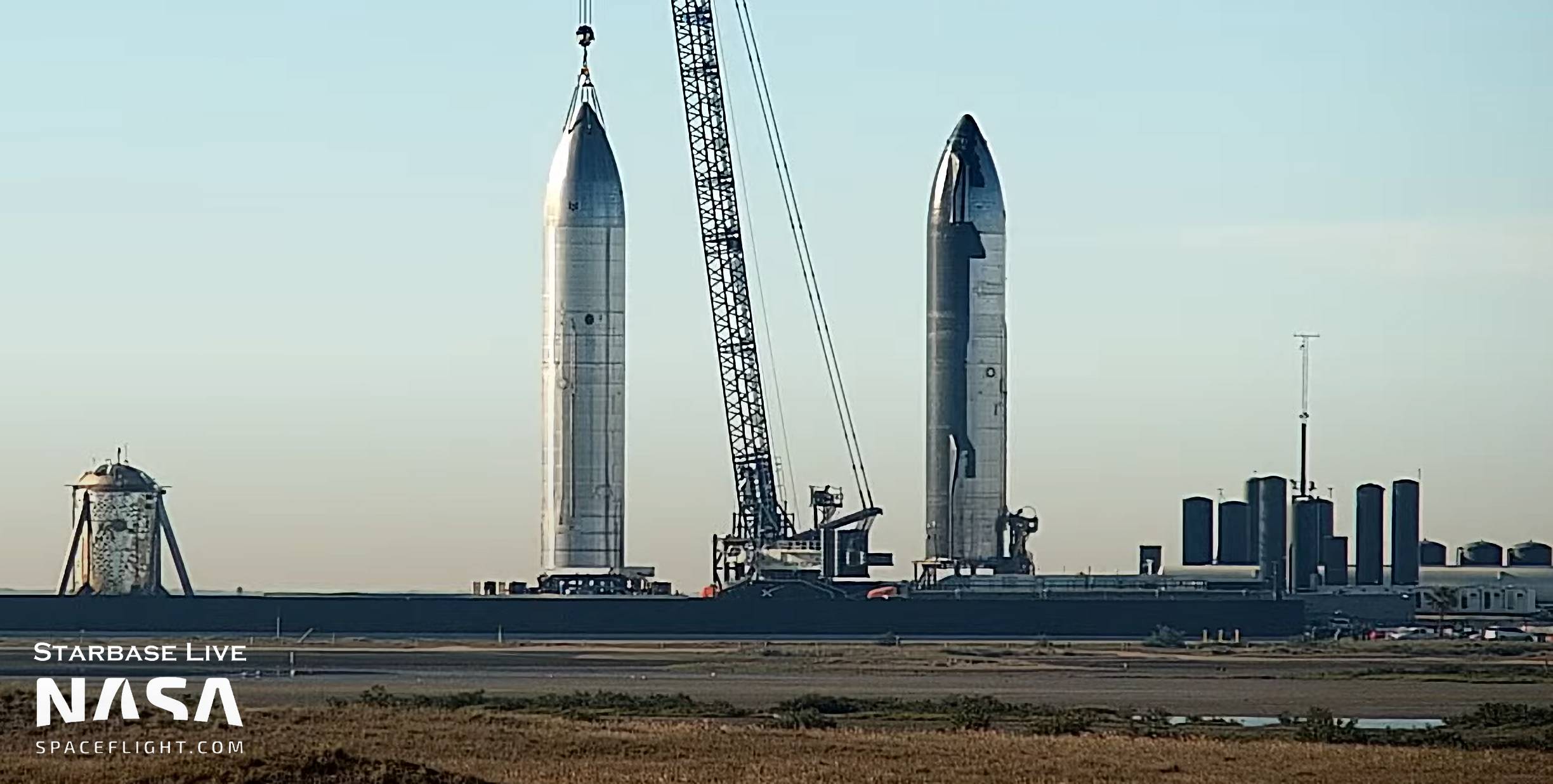
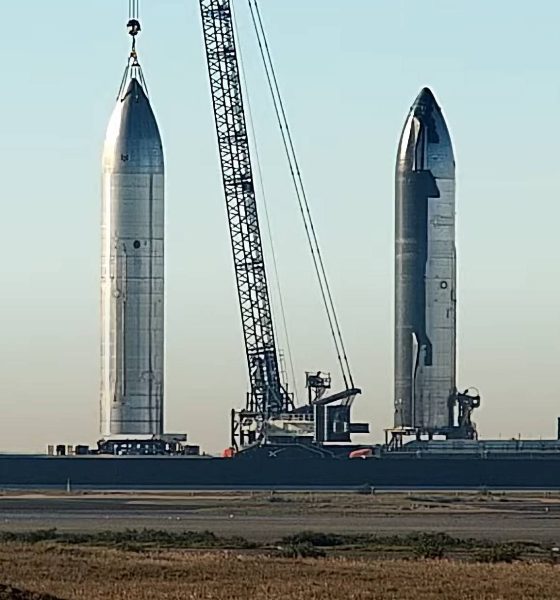
News
SpaceX rolls naked Starship prototype to test site
SpaceX has rolled a strange, naked Starship prototype from its Starbase, Texas factory to a nearby test site.
Beginning with its cone-tipped nose section, SpaceX started stacking Starship S26 in October 2022. By early January 2023, the prototype had been stacked to its full 50-meter (~165 ft) height and welded together. After about six more weeks of outfitting, Ship 26 left Starbase’s High Bay assembly facility and was transported to one of two stands formerly used for suborbital Starship test flights.
SpaceX lifted Ship 26 onto Suborbital Pad A on the morning of February 12th. Just a few hundred feet to the left, Starship prototype S25 watched from Suborbital Pad B while waiting for the start of its Raptor engine test campaign. Ship 26 is four months younger than Ship 25 and rolled out without Raptors installed, as it still needs to pass several simpler tests. That’s far from the only difference between the Starships.
The update that's rolling out to the fleet makes full use of the front and rear steering travel to minimize turning circle. In this case a reduction of 1.6 feet just over the air— Wes (@wmorrill3) April 16, 2024
Starbullet
Aside from a range of smaller design changes, Ship 26 has three main differences relative to most prior Starships. First, it has zero heat shield tiles. Since the 2020-2021 period of suborbital Starship flight testing, all finished ships (S20, S21, S22, S24, S25) have been fitted with ~10,000 black, ceramic heat shield tiles. Eventually, those tiles will (theoretically) protect Starships from the intense heat created by reentering Earth’s atmosphere at orbital velocity.
Ship 26 also has no flaps. Since SpaceX first fully assembled a Starship in October 2020, every ship the company has completed (SN8, SN9, SN10, SN11, SN15, SN16, S20, S21, S22, S24, S25) has had four large flaps and form-fitting ‘aerocovers’ installed. Starships need flaps to steer and orient themselves during orbital reentries. They also need flaps to control themselves during exotic landing maneuvers, which require ships to free-fall belly-down (like a human skydiver) and aggressively flip into a vertical orientation for propulsive landings.
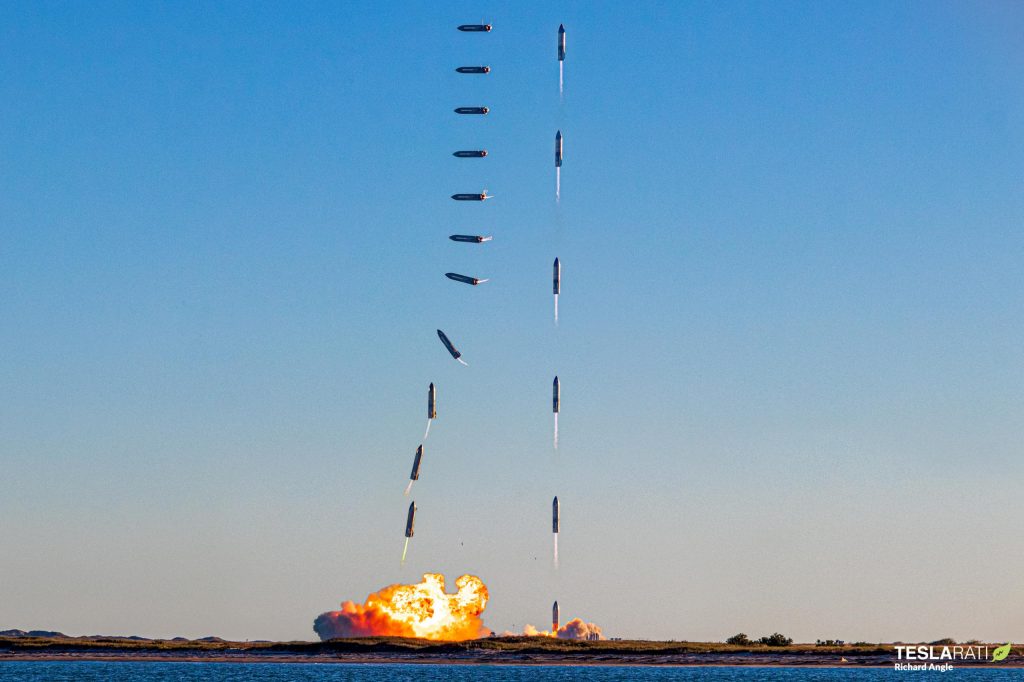
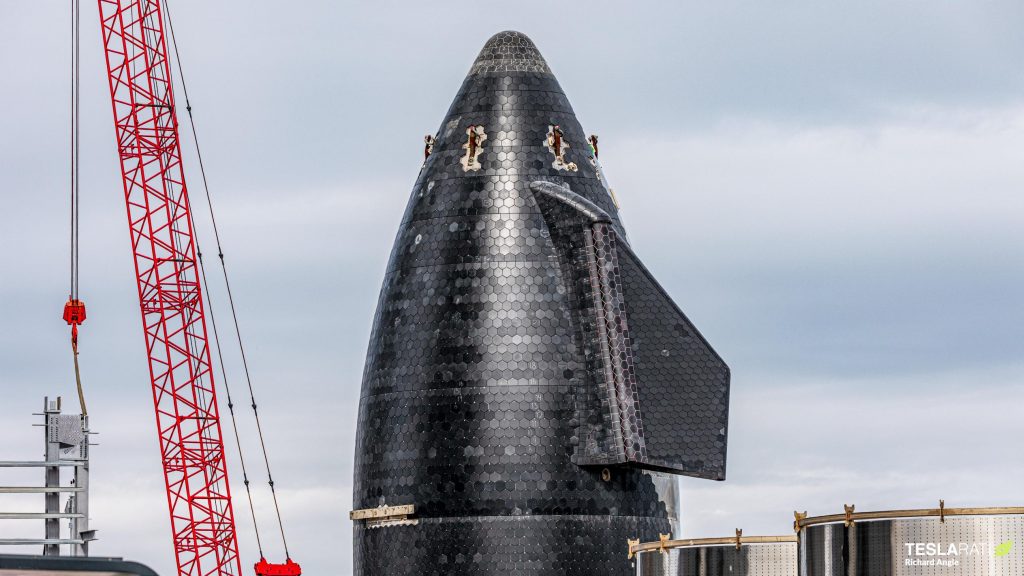
Finally, and most confusingly, Ship 26 has no payload bay of any kind. The end result is a smooth, featureless Starship that looks like a steel bullet, can’t return to Earth, and can’t deploy satellites. Combined, the fact it exists at all almost seems like an elaborate, multi-month mistake. But SpaceX clearly intended to build Ship 26 and is now preparing to qualify it for flight.
Depot, Moon lander, or something else?
In simpler terms, Ship 26 is an intentionally expendable Starship with no way to launch satellites. That raises the obvious question: why does it exist? There are a few obvious possibilities. SpaceX is developing at least four types of Starships. The Crew and Tanker Ships will have heat shields and flaps. The Starship Moon lander will have no flaps or heat shield and will be painted white and insulated. A Depot Ship with stretched tanks will stay in orbit permanently and store propellant for in-space refilling.
Based on low-resolution renders, the bullet-like Depot Ship is the most reminiscent of Ship 26. However, there’s no evidence that Ship 26 has “exterior optical properties [optimized] for long duration [propellant storage].” The prototype also lacks any of the hardware likely needed for docking or propellant transfer and has propellant tanks that are the same size as past ships. To survive in orbit for days or weeks, it would need some kind of power source – typically solar arrays – that isn’t present. And even if an expendable Starship like S26 can already achieve SpaceX’s reported target of 250 tons (~550,000 lb) to low Earth orbit, 250 tons is only a fifth of a full propellant load.

Ship 26 could also be used for miscellaneous systems testing or a longevity demonstration in orbit. However, it’s unclear why SpaceX couldn’t simply do that with Ship 24 and Ship 25. Both have had their payload bays permanently sealed, meaning that they are only useful as test articles. The same is true for a tank-to-tank propellant transfer test SpaceX received a NASA contract to conduct in 2020. During that test, Starship will transfer “10 metric tons” of cryogenic liquid oxygen (LOx) between its main LOx tank and a smaller header LOx tank used to store landing propellant. But all Starships built to date have header tanks and could be used for the same test.
Ship 26 could exist primarily to demonstrate that a Starship with no flaps or heat shield tiles is aerodynamically stable during launch. However, expending an entire Starship for what amounts to wind tunnel testing would be extravagant.
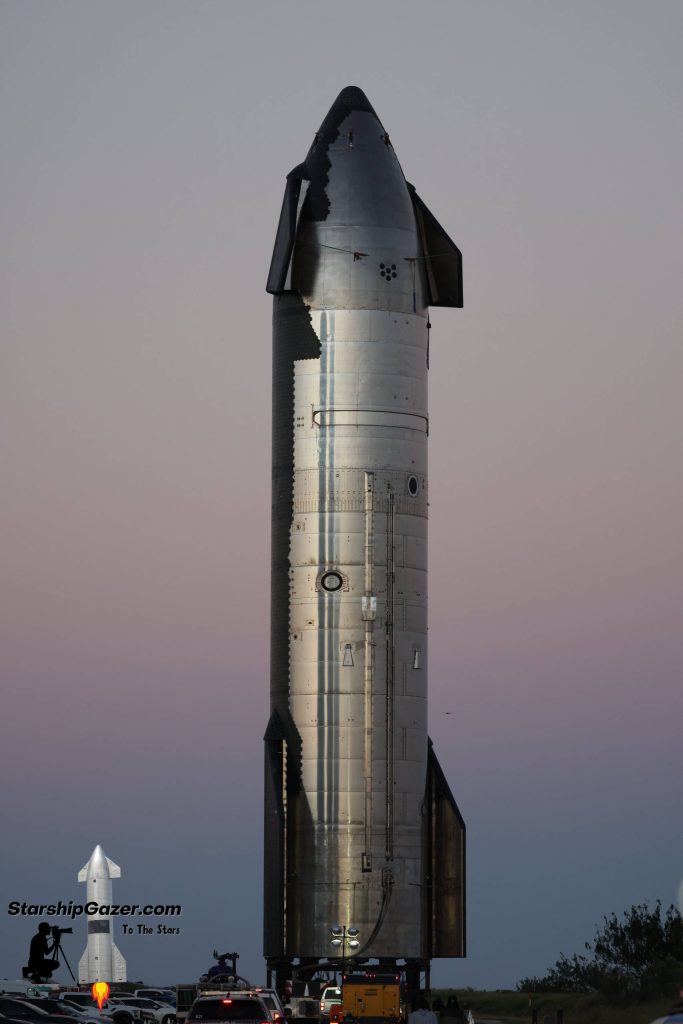
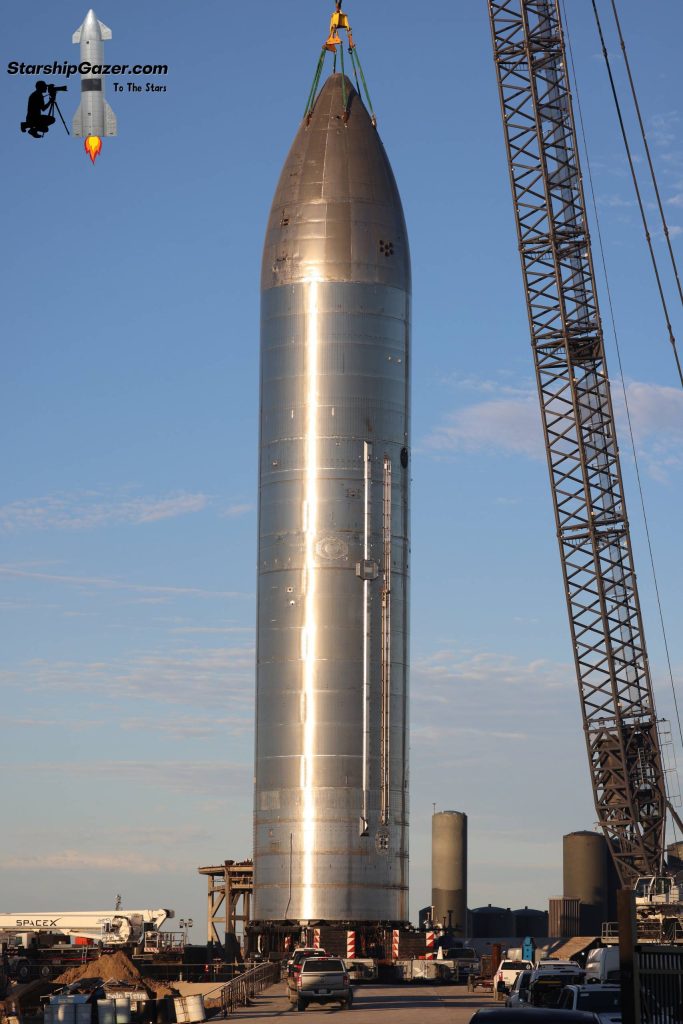
Preparing for flight
Regardless, Ship 26 is clearly destined for more than the scrapyard. The bullet-like prototype was installed on Suborbital Pad A, which SpaceX has modified for cryogenic proofing and structural testing. While coordinating with Ship 25, which needs to conduct static fire tests, Ship 26 will be pressurized and loaded with liquid nitrogen, liquid oxygen, or both to safely simulate the thermal and mechanical loads it will experience when filled with propellant. The stand is fitted with hydraulic rams that can simultaneously simulate the thrust of six Raptor engines (1380 tons / 3M lbf).
If it passes those tests, SpaceX will presumably return Ship 26 to the Starbase factory for Raptor installation. Strangely, the smooth Starship isn’t alone. It appears that Ship 27 will be more or less identical, with no heat shield or flaps. However, there’s evidence that Ship 27 will have the first working payload bay on a Starship and could be used to deploy full-size Starlink V2 satellites in addition to any other testing SpaceX wants to use it for.
The most exotic (and unlikeliest) explanation for Ship 26 and Ship 27 is that the pair is meant to support SpaceX’s first Starship docking and propellant transfer test. In October 2022, a NASA official indicated that SpaceX’s second Starship test flight would be a “Starship-to-Starship propellant transfer.”
For now, SpaceX’s priority is preparing Ship 24 and Super Heavy Booster 7 for Starship’s first orbital launch attempt, followed by preparing Ship 25 and Booster 9 for the second orbital test flight. Until then, Ship 26 and Ship 27 will likely remain a bit of a mystery.

News
Elon Musk’s Grok AI to be used in U.S. War Department’s bespoke AI platform
The partnership aims to provide advanced capabilities to 3 million military and civilian personnel.

The U.S. Department of War announced Monday an agreement with Elon Musk’s xAI to embed the company’s frontier artificial intelligence systems, powered by the Grok family of models, into the department’s bespoke AI platform GenAI.mil.
The partnership aims to provide advanced capabilities to 3 million military and civilian personnel, with initial deployment targeted for early 2026 at Impact Level 5 (IL5) for secure handling of Controlled Unclassified Information.
xAI Integration
As noted by the War Department’s press release, GenAI.mil, its bespoke AI platform, will gain xAI for the Government’s suite of tools, which enable real-time global insights from the X platform for “decisive information advantage.” The rollout builds on xAI’s July launch of products for U.S. government customers, including federal, state, local, and national security use cases.
“Targeted for initial deployment in early 2026, this integration will allow all military and civilian personnel to use xAI’s capabilities at Impact Level 5 (IL5), enabling the secure handling of Controlled Unclassified Information (CUI) in daily workflows. Users will also gain access to real‑time global insights from the X platform, providing War Department personnel with a decisive information advantage,” the Department of War wrote in a press release.
Strategic advantages
The deal marks another step in the Department of War’s efforts to use cutting-edge AI in its operations. xAI, for its part, highlighted that its tools can support administrative tasks at the federal, state and local levels, as well as “critical mission use cases” at the front line of military operations.
“The War Department will continue scaling an AI ecosystem built for speed, security, and decision superiority. Newly IL5-certified capabilities will empower every aspect of the Department’s workforce, turning AI into a daily operational asset. This announcement marks another milestone in America’s AI revolution, and the War Department is driving that momentum forward,” the War Department noted.
News
Tesla FSD (Supervised) v14.2.2 starts rolling out
The update focuses on smoother real-world performance, better obstacle awareness, and precise end-of-trip routing, among other improvements.

Tesla has started rolling out Full Self-Driving (Supervised) v14.2.2, bringing further refinements to its most advanced driver-assist system. The new FSD update focuses on smoother real-world performance, better obstacle awareness, and precise end-of-trip routing, among other improvements.
Key FSD v14.2.2 improvements
As noted by Not a Tesla App, FSD v14.2.2 upgrades the vision encoder neural network with higher resolution features, enhancing detection of emergency vehicles, road obstacles, and human gestures. New Arrival Options let users select preferred drop-off styles, such as Parking Lot, Street, Driveway, Parking Garage, or Curbside, with the navigation pin automatically adjusting to the user’s ideal spot for precision.
Other additions include pulling over for emergency vehicles, real-time vision-based detours for blocked roads, improved gate and debris handling, and extreme Speed Profiles for customized driving styles. Reliability gains cover fault recovery, residue alerts on the windshield, and automatic narrow-field camera washing for new 2026 Model Y units.
FSD v14.2.2 also boosts unprotected turns, lane changes, cut-ins, and school bus scenarios, among other things. Tesla also noted that users’ FSD statistics will be saved under Controls > Autopilot, which should help drivers easily view how much they are using FSD in their daily drives.
Key FSD v14.2.2 release notes
Full Self-Driving (Supervised) v14.2.2 includes:
- Upgraded the neural network vision encoder, leveraging higher resolution features to further improve scenarios like handling emergency vehicles, obstacles on the road, and human gestures.
- Added Arrival Options for you to select where FSD should park: in a Parking Lot, on the Street, in a Driveway, in a Parking Garage, or at the Curbside.
- Added handling to pull over or yield for emergency vehicles (e.g. police cars, fire trucks, ambulances).
- Added navigation and routing into the vision-based neural network for real-time handling of blocked roads and detours.
- Added additional Speed Profile to further customize driving style preference.
- Improved handling for static and dynamic gates.
- Improved offsetting for road debris (e.g. tires, tree branches, boxes).
- Improve handling of several scenarios, including unprotected turns, lane changes, vehicle cut-ins, and school buses.
- Improved FSD’s ability to manage system faults and recover smoothly from degraded operation for enhanced reliability.
- Added alerting for residue build-up on interior windshield that may impact front camera visibility. If affected, visit Service for cleaning!
- Added automatic narrow field washing to provide rapid and efficient front camera self-cleaning, and optimize aerodynamics wash at higher vehicle speed.
- Camera visibility can lead to increased attention monitoring sensitivity.
Upcoming Improvements:
- Overall smoothness and sentience.
- Parking spot selection and parking quality.
News
Tesla is not sparing any expense in ensuring the Cybercab is safe
Images shared by the longtime watcher showed 16 Cybercab prototypes parked near Giga Texas’ dedicated crash test facility.

The Tesla Cybercab could very well be the safest taxi on the road when it is released and deployed for public use. This was, at least, hinted at by the intensive safety tests that Tesla seems to be putting the autonomous two-seater through at its Giga Texas crash test facility.
Intensive crash tests
As per recent images from longtime Giga Texas watcher and drone operator Joe Tegtmeyer, Tesla seems to be very busy crash testing Cybercab units. Images shared by the longtime watcher showed 16 Cybercab prototypes parked near Giga Texas’ dedicated crash test facility just before the holidays.
Tegtmeyer’s aerial photos showed the prototypes clustered outside the factory’s testing building. Some uncovered Cybercabs showed notable damage and one even had its airbags engaged. With Cybercab production expected to start in about 130 days, it appears that Tesla is very busy ensuring that its autonomous two-seater ends up becoming the safest taxi on public roads.
Prioritizing safety
With no human driver controls, the Cybercab demands exceptional active and passive safety systems to protect occupants in any scenario. Considering Tesla’s reputation, it is then understandable that the company seems to be sparing no expense in ensuring that the Cybercab is as safe as possible.
Tesla’s focus on safety was recently highlighted when the Cybertruck achieved a Top Safety Pick+ rating from the Insurance Institute for Highway Safety (IIHS). This was a notable victory for the Cybertruck as critics have long claimed that the vehicle will be one of, if not the, most unsafe truck on the road due to its appearance. The vehicle’s Top Safety Pick+ rating, if any, simply proved that Tesla never neglects to make its cars as safe as possible, and that definitely includes the Cybercab.








